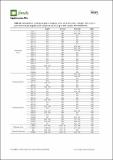Por favor, use este identificador para citar o enlazar a este item:
http://hdl.handle.net/10261/250111COMPARTIR / EXPORTAR:
 SHARE SHARE
 CORE
BASE CORE
BASE
|
|
| Visualizar otros formatos: MARC | Dublin Core | RDF | ORE | MODS | METS | DIDL | DATACITE | |

| Título: | NGS Techniques Reveal a High Diversity of RNA Viral Pathogens and Papillomaviruses in Fresh Produce and Irrigation Water |
Autor: | Itarte, Marta; Martínez-Puchol, Sandra; Forés, Eva; Hundesa, Ayalkibet; Timoneda Solé, Natàlia CSIC ORCID CVN ; Bofill-Mas, Sílvia; Girones, Rosina; Rusiñol, Marta CSIC ORCID | Palabras clave: | Organic food Irrigation water Viral pathogens Food safety Next-generation sequencing Target enrichment sequencing Amplicon deep sequencing Human papillomavirus Norovirus Vertebrate viruses |
Fecha de publicación: | ago-2021 | Editor: | Multidisciplinary Digital Publishing Institute | Citación: | Foods 10(8): 1820 (2021) | Resumen: | Fresh fruits and vegetables are susceptible to microbial contamination at every stage of the food production chain, and as a potential source of pathogens, irrigation water quality is a critical factor. Next-generation sequencing (NGS) techniques have been flourishing and expanding to a wide variety of fields. However, their application in food safety remains insufficiently explored, and their sensitivity requires improvement. In this study, quantitative polymerase chain reaction (qPCR) assays showed low but frequent contamination of common circulating viral pathogens, which were found in 46.9% of samples of fresh produce: 6/12 lettuce samples, 4/12 strawberries samples, and 5/8 parsley samples. Furthermore, the application of two different NGS approaches, target enrichment sequencing (TES) for detecting viruses that infect vertebrates and amplicon deep sequencing (ADS), revealed a high diversity of viral pathogens, especially Norovirus (NoV) and Human Papillomavirus (HPV), in fresh produce and irrigation water. All NoV and HPV types found in fresh fruit and vegetable samples were also detected in irrigation water sources, indicating that these viruses are common circulating pathogens in the population and that irrigation water may be the most probable source of viral pathogens in food samples | Descripción: | Special issue Next-Generation Sequencing and Emerging Technologies for the Identification and Control of Microbial Contaminants in the Food Chain.-- 21 pages, 2 figures, 5 tables, supplementary materials https://www.mdpi.com/article/10.3390/foods10081820/s1.-- Data Availability Statement: The datasets generated during the current study are available in Zenodo under the DOI number https://doi.org/10.5281/zenodo.4722797 | Versión del editor: | https://doi.org/10.3390/foods10081820 | URI: | http://hdl.handle.net/10261/250111 | DOI: | 10.3390/foods10081820 | E-ISSN: | 2304-8158 |
| Aparece en las colecciones: | (ICM) Artículos (IDAEA) Artículos |
Ficheros en este ítem:
| Fichero | Descripción | Tamaño | Formato | |
|---|---|---|---|---|
| Itarte_et_al_2021.pdf | 1,26 MB | Adobe PDF |  Visualizar/Abrir | |
| Itarte_et_al_2021_suppl.pdf | 227,11 kB | Adobe PDF |  Visualizar/Abrir |
CORE Recommender
SCOPUSTM
Citations
12
checked on 08-may-2024
WEB OF SCIENCETM
Citations
10
checked on 20-feb-2024
Page view(s)
101
checked on 15-may-2024
Download(s)
185
checked on 15-may-2024
Google ScholarTM
Check
Altmetric
Altmetric
Este item está licenciado bajo una Licencia Creative Commons



